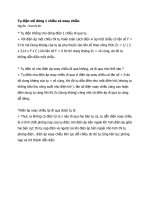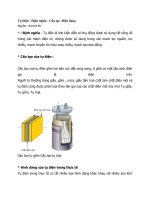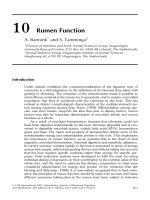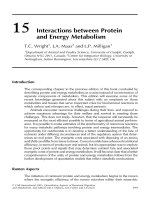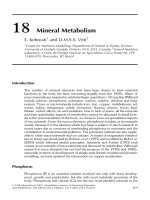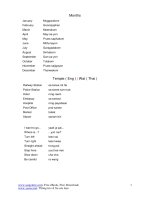Tài liệu Tự điển Food Science, Technology And Nutrition -Vần E docx
Bạn đang xem bản rút gọn của tài liệu. Xem và tải ngay bản đầy đủ của tài liệu tại đây (192.58 KB, 20 trang )
coloured pulp, with a smell considered disgusting by the
uninitiated.
Composition/100 g: (edible portion 32%) water 65 g, 615kJ
(147 kcal), protein 1.5 g, fat 5.3g, carbohydrate 27.1 g, fibre 3.8 g,
ash 1.1 g, Ca 6 mg, Fe 0.4 mg, Mg 30 mg, P 39 mg, K 436 mg, Na
2mg, Zn 0.3 mg, Cu 0.2mg, Mn 0.3mg, vitamin A 2µg RE (29µg
carotenoids), B
1
0.37 mg, B
2
0.2 mg, niacin 1.1 mg, B
6
0.32 mg,
folate 36 µg, pantothenate 0.2 mg, C 20 mg. A 150 g serving
(quarter fruit) is a source of Mg, Mn, vitamin B
2
,a good source
of Cu, vitamin B
6
, folate, a rich source of vitamin B
1
,C.
durum wheat A hard type of wheat, Triticum durum (most bread
wheats are T. vulgare); mainly used for the production of
semolina for preparation of pasta.
Dutching See cocoa, dutch.
Dutch oven A semicircular metal shield which may be placed
close to an open fire; fitted with shelves on which food is roasted.
It may also be clamped to the fire bars.
D value See decimal reduction time.
dwb See dry weight basis.
Dynabeads
TM
Magnetic microspheres coated with antibodies,
used in immunomagnetic separation.
Dyox
TM
Chlorine dioxide used to treat flour, see ageing.
dysentery Infection of the intestinal tract causing severe diar-
rhoea with blood and mucus. Amoebic dysentery is caused by
Entamoeba histolytica, and occasionally other protozoans spread
by contaminated food and water. Symptoms may develop many
months after infection. Bacillary dysentery is caused by Shigella
spp.; symptoms develop 1–6 days after infection.
dysgeusia Distortion of the sense of taste, a common side-effect
of some drugs.
See also gustin; hypogeusia; parageusia.
dyspepsia Any pain or discomfort associated with eating; may be
a symptom of gastritis, peptic ulcer, gall-bladder disease, etc.;
functional dyspepsia occurs when there is no obvious structural
change in the intestinal tract. Treatment includes a bland
diet.
See also indigestion.
dysphagia Difficulty in swallowing, commonly associated with
disorders of the oesophagus. Inability to swallow is aphagia.
E
e On food labels, before the weight or volume, to indicate that
this has been notified to the regulatory authorities of the EU as
a standard package size.
162
E See e-numbers and Table 7 of the Appendix.
EAA index Essential amino acid index, an index of protein
quality.
earth almond See tiger nut.
earth nut A very small variety of truffle, Conopodium denuda-
tum, also called pig nut and fairy potato. Also another name for
the peanut.
eau de vie Spirit distilled from fermented grape juice (sometimes
other fruit juices); may be flavoured with fruits, etc.
See also marc (1).
echoviruses A group of RNA-containing viruses that infect the
gastrointestinal tract and produce pathological changes in cells
in culture, but not associated with any specific disease. Now
usually classified as coxsackie viruses.
See also enteroviruses; reovirus.
Eck fistula See fistula.
EC numbers Systematic classification of enzymes by the class,
subclass, sub-subclass and individual reaction classified, shown
as EC x.x.x.x. The classes are: (1) oxidoreductases, (2) trans-
ferases, (3) hydrolases, (4) lyases, (5) isomerases, (6) ligases
(synthetases).
E. coli (Escherichia coli) Group of bacteria including both harm-
less commensals in the human gut and strains that cause food
poisoning by production of enterotoxins (TX 3.1.2.x, 3.1.3.x,
3.1.4.x, depending on the strain) after adhering to intestinal
epithelial cells. For most pathogenic strains the infective dose is
10
5
–10
7
organisms, onset 16–48 h, and duration 1–3 days.
Strain O157:H7 (or VTEC) was first identified as a cause of
food poisoning in the 1980s. It produces a toxin called verocyto-
toxin and is especially virulent; infective dose 10 organisms, onset
1–7 h and duration (if not fatal) of days or weeks.
ectomorph Description given to a tall, thin person, possibly with
underdeveloped muscles.
See also endomorph; mesomorph.
ecuelle Apparatus for obtaining peel oil from citrus fruit. It con-
sists of a shallow funnel lined with spikes on which the fruit is
rolled by hand. As the oil glands are pierced, the oil and cell sap
collect in the bottom of the funnel.
eddo See taro.
edema See oedema.
edetate See edta.
edible portion Used in food composition tables to indicate that
the data refer to the part of the food that is usually eaten – e.g.
excluding skin or pips of fruit and vegetables, bones in meat and
fish.
163
Edifas
TM
cellulose derivatives: Edifas A is methyl ethyl cellu-
lose (E-465); Edifas B, sodium carboxymethylcellulose (E-466).
Edman reagent Phenylisothiocyanate (PIC); reacts with amino
terminal amino acid of a protein; the basis of the Edman degra-
dation used in sequencing proteins, and used in hplc of amino
acids for fluorimetric detection.
Edosol
TM
A low-sodium milk substitute, containing 43 mg
sodium/100 g, compared with dried milk at 400 mg.
EDTA Ethylene diamine tetra-acetic acid, a chelating agent that
forms stable chelation complexes with metal ions. Also called
versene, sequestrol and sequestrene. It can be used both to
remove metal ions from a solution (or at least to remove them
from activity) and also to add metal ions, for example in plant
fertilisers (E-385).
eel A long thin fish, Anguilla spp.; the European eel is A. anguilla,
the conger eel is Conger myriaster. Eels live in rivers but go to
sea to breed. To date, although elvers (young eels) have been
caught and raised in tanks, it has not been possible to breed them
in captivity.
Composition/100 g: water 68 g, 770 kJ (184 kcal), protein 18.4g,
fat 11.7 g (of which 23% saturated, 69% mono-unsaturated, 9%
polyunsaturated), cholesterol 126mg, carbohydrate 0g, ash 1.4 g,
Ca 20 mg, Fe 0.5 mg, Mg 20 mg, P 216 mg, K 272 mg, Na 51 mg, Zn
1.6 mg, Se 6.5 µg, I 80 µg, vitamin A 1043 µg retinol, E 4 mg, B
1
0.15 mg, B
2
0.04 mg, niacin 3.5mg, B
6
0.07 mg, folate 15µg, B
12
3 µg, pantothenate 0.2 mg, C 2mg. A 100 g serving is a source of
niacin, a good source of P, a rich source of I, vitamin A, E, B
12
.
EFA Essential fatty acids. See fatty acids, essential.
Efamast
TM
A preparation of γ-linolenic acid, as a dietary
supplement.
effective freezing time Time required to lower the temperature
of a food from an initial value to a predetermined final
temperature.
EFSA European Food Safety Authority; web site http://
www.efsa.eu.int/.
egg Hen eggs are graded by size. In EU, weight ranges are used:
very large eggs 73 g or over, large 63–73 g, medium 53–63 g and
small 53 g or less. In USA average weights are used: jumbo
70.0 g, extra large 63.8 g, large 56.7, g, medium 49.6g, small 42.5 g
and peewee 35.4 g.
Composition/100 g: (edible portion 88%) water 75.8g, 615 kJ
(147 kcal), protein 12.6 g, fat 9.9g (of which 37% saturated, 46%
mono-unsaturated, 17% polyunsaturated), carbohydrate 0.8 g
(0.8 g sugars), ash 0.9g, Ca 53 mg, Fe 1.8 mg, Mg 12 mg, P 191 mg,
K 134 mg, Na 140 mg, Zn 1.1 mg, Cu 0.1 mg, Se 31.7 µg, I 53 µg,
164
vitamin A 140 µg RE (139 µg retinol, 350 µg carotenoids), E 1 mg,
K 0.3 mg, B
1
0.07 mg, B
2
0.48 mg, niacin 0.1mg, B
6
0.14 mg, folate
47 µg, B
12
1.3 µg, pantothenate 1.4 mg.A 75g serving (1 large egg)
is a source of P, vitamin A, folate, pantothenate, a good source of
I, vitamin B
2
,a rich source of Se, vitamin B
12
.
Duck eggs weigh around 85 g. Composition/100 g: (edible
portion 88%) water 70.8 g, 774 kJ (185 kcal), protein 12.8g, fat
13.8 g (of which 32% saturated, 57% mono-unsaturated, 11%
polyunsaturated), cholesterol 884mg, carbohydrate 1.5 g (0.9 g
sugars), ash 1.1g, Ca 64 mg, Fe 3.8 mg, Mg 17 mg, P 220mg, K
222 mg, Na 146mg, Zn 1.4mg, Cu 0.1 mg, Se 36.4 µg, vitamin A
194 µg RE (192 µg retinol, 485 µg carotenoids), E 1.3mg, K
0.4 mg, B
1
0.16 mg, B
2
0.4 mg, niacin 0.2 mg, B
6
0.25 mg, folate
80 µg, B
12
5.4 µg, pantothenate 1.9mg. An 85 g serving (1 egg) is
a source of vitamin E, a good source of Fe, P, vitamin A, B
2
, pan-
tothenate, a rich source of Se, folate, vitamin B
12
.
Quail eggs weigh around 10 g. Composition/100 g: (edible
portion 92%) water 74.3 g, 661 kJ (158 kcal), protein 13.1g, fat
11.1 g (of which 39% saturated, 47% mono-unsaturated, 14%
polyunsaturated), cholesterol 844mg, carbohydrate 0.4 g (0.4 g
sugars) ash 1.1 g, Ca 64mg, Fe 3.7 mg, Mg 13mg, P 226 mg, K
132 mg, Na 141mg, Zn 1.5 mg, Cu 0.1 mg, Se 32 µg, vitamin A
156 µg RE (155 µg retinol, 390 µg carotenoids), E 1.1mg, K
0.3 mg, B
1
0.13 mg, B
2
0.79 mg, niacin 0.2 mg, B
6
0.15 mg, folate
66 µg, B
12
1.6 µg, pantothenate 1.8 mg. A 10 g serving (1 egg) is a
source of vitamin B
12
.
egg plant See aubergine.
egg proteins What is generally referred to as egg protein is a
mixture of proteins, including ovalbumin, ovomucoid, ovoglobu-
lin, conalbumin, vitellin and vitellenin. egg white contains 11%
protein, mostly ovalbumin; yolk contains 16% protein, mainly
two phosphoproteins, vitellin and vitellenin.
eggs, Chinese (or hundred year old eggs) Known as pidan, houei-
dan and dsaoudan, depending on variations in the method of
preparation. Prepared by covering fresh duck eggs with a
mixture of sodium hydroxide, burnt straw ash and slaked lime,
then storing for several months (sometimes referred to as
‘hundred year old eggs’). The white and yolk coagulate and
become discoloured, with partial decomposition of the protein
and phospholipids.
egg substitute Name formerly used for golden raising powder, a
type of baking powder.
egg white The white of an egg is in three layers: an outer layer of
thin white, layer of thick white, richer in ovomucin, and inner
layer of thin white surrounding the yolk. The ratio of thick to
165
thin white varies, depending on the individual hen. A higher pro-
portion of thick white is desirable for frying and poaching, since
it helps the egg to coagulate into a small firm mass instead of
spreading; thin white produces a larger volume of froth when
beaten than does thick.
See also egg proteins.
egg white injury biotin deficiency caused by consumption of large
quantities of uncooked egg white.
EGRAC Erythrocyte glutathione reductase activation
coefficient.
eicosanoids Compounds formed in the body from C20 polyun-
saturated fatty acids (eicosenoic acids), including the
prostaglandins, prostacyclins, thromboxanes and leukotrienes,
all of which act as local hormones, and are involved in wound
healing, inflammation, platelet aggregation, and a variety of
other functions.
eicosapentaenoic acid (EPA) A long chain polyunsaturated fatty
acid (C20:5 ω3). See fish oils.
eicosenoic acids Long chain polyunsaturated fatty acids with 20
carbon atoms.
einkorn A type of wheat, the wild form of which, Triticum
boeoticum, was probably one of the ancestors of all cultivated
wheat. Still grown in some parts of southern Europe and Middle
East, usually for animal feed. The name means ‘one seed’, from
the single seed found in each spikelet.
eiswein wine made from grapes that have frozen on the vine,
picked and processed while still frozen, so that the juice is highly
concentrated and very sweet. Similar Canadian wines are known
as ice wine.
elastase A proteolytic enzyme (EC 3.4.21.36) in pancreatic juice,
an endopeptidase. Active at pH 8–11. Secreted as the inactive
precursor, pro-elastase, which is activated by trypsin.
elastin Insoluble protein in connective tissue; the cause of
toughness in meat. Unlike collagen, it is unaffected by cooking.
elderberry Fruit of Sambucus niger.
Composition/100 g: water 80g, 306 kJ (73 kcal), protein 0.7 g, fat
0.5 g, carbohydrate 18.4 g, fibre 7g, ash 0.6 g, Ca 38 mg, Fe 1.6 mg,
Mg 5 mg, P 39 mg, K 280 mg, Na 6 mg, Zn 0.1 mg, Cu 0.1mg,
Se 0.6 µg, vitamin A 30 µg RE, B
1
0.07 mg, B
2
0.06 mg, niacin
0.5 mg, B
6
0.23 mg, folate 6 µg, pantothenate 0.1mg, C 36mg. A
110 g serving is a source of Fe, vitamin B
6
,a rich source of
vitamin C.
electrodialysis Combined use of electrolysis and ion-selective
membranes to separate electrolytes and ion-selective
membranes.
166
electrofocusing See isoelectric focusing.
electrolysis Separation of ions in a solution by use of direct
current. See also electrolytes.
electrolytes Salts that dissociate in solution and hence will carry
an electric current; generally used to mean the inorganic ions in
blood plasma and other body fluids, especially sodium, potas-
sium, chloride, bicarbonate and phosphate.
electronic heating See microwave cooking.
electron transport chain A sequence of coenzymes and
cytochromes of differing redox potential. In the mitochondria
they carry electrons from the oxidation of metabolic fuels
leading to the reduction of oxygen to water, and are obligatorily
linked to oxidative phosphorylation.
electrophoresis Technique for separation of charged molecules
(especially proteins and nucleic acids) by their migration in an
electric field. The support medium may be a starch or polyacry-
lamide gel, paper or cellulose acetate.
electroporation Use of high-voltage electric pulses at low-voltage
gradients to exchange genetic information between protoplast
cells of micro-organisms, plants or animals. At high-voltage gra-
dients (up to 30 kV/cm) used to sterilise or pasteurise food by
permeabilisation of bacterial cell membranes.
See also pasteurisation; sterile.
electropure process A method for pasteurisation of milk by
passing low-frequency, alternating current.
elemental diet See formula diet.
elements, minor See minerals, trace; minerals, ultratrace.
ELISA (enzyme-linked immunosorbent assay) Sensitive and spe-
cific analytical technique for determination of analytes present
at very low concentrations in biological samples, in which either
the tracer analyte or the antibody is bound to an enzyme; the
product of the enzyme may be measured directly, or may be a
catalyst or coenzyme for a second enzyme, giving considerable
amplification, and hence permitting high sensitivity without the
use of radioactive tracers.
See also fluorescence immunoassay; radioimmunoassay.
elixir Alcoholic extract (tincture) of a naturally occurring sub-
stance; originally devised by medieval alchemists (the elixir of
life), now used for a variety of medicines, liqueurs and bitters.
elute To wash off or remove. Specifically applied to removal of
adsorbed compounds in chromatography.
See also ion-exchange resin.
elutriation Technique for separating fine and coarse particles by
suspending the mixture in water and decanting the upper layer
while it still contains the finer particles.
167
elver Young eel, about 5cm in length.
EM Electron microscope or microscopy, see microscope,
electron.
emaciation Extreme thinness and wasting, caused by disease or
undernutrition.
See also cachexia; marasmus; protein–energy malnutrition.
Embden groats See groats.
emblic Berry of the S.E. Asian malacca tree, Emblica officinalis,
similar in appearance to the gooseberry. Also known as the
Indian gooseberry. An exceptionally rich source of vitamin C,
600 mg/100 g.
embolism Blockage of a blood vessel caused by a foreign object
(embolus) such as a quantity of air or gas, a piece of tissue or
tumour, a blood clot (thrombus) or fatty tissue derived from
atheroma, in the circulation.
embolus See embolism.
emetic Substance that causes vomiting.
Emmental Swiss hard cheese, used in fondue.
emmer A type of wheat known to have been used more than
8000 years ago. Wild emmer is Triticum dicoccoides and true
emmer is T. dicoccum. Nowadays grown mainly for animal feed.
Emprote
TM
A dried milk and cereal preparation consumed as a
beverage, containing 33% protein.
EMS See eosinophilia myalgia syndrome.
emu Flightless Australian bird, Dromaius novaehollandiae,
weighing 50–60 kg, farmed as a source of low-fat meat.
Composition/100 g: water 75 g, 431 kJ (103 kcal), protein 22.5g,
fat 0.8 g, cholesterol 71 mg, carbohydrate 0g, ash 1.1 g, Ca 3 mg,
Fe 4.5 mg, Mg 42mg, P 236mg, K 300 mg, Na 120 mg, Zn 3.5 mg,
Cu 0.2 mg, Se 32.5 µg, vitamin E 0.2 mg, B
1
0.27 mg, B
2
0.45 mg,
niacin 7.4 mg, B
6
0.63 mg, folate 13 µg, B
12
6.7 µg, pantothenate 2.7
mg. A 100 g serving is a source of Cu, Mg, vitamin B
1
,a good
source of P, Zn, vitamin B
2
,a rich source of Fe, Se, niacin, vitamin
B
6
,B
12
, pantothenate.
emulsification Reduction in droplet size of immiscible liquids to
achieve a stable emulsion. Also known as homogenisation.
emulsifiers (emulsifying agents) Substances that are soluble
in both fat and water; enable fat to be uniformly dispersed
in water as an emulsion. stabilisers maintain emulsions
in a stable form. Emulsifying agents are also used in baking
to aid the smooth incorporation of fat into the dough and to
keep the crumb soft. Emulsifying agents used in foods
include agar, albumin, alginates, casein, egg yolk, glyceryl
monostearate, gums, irish moss, lecithin, soaps. See
Table 7 of the Appendix.
168
emulsifying salts Sodium citrate, sodium phosphates and sodium
tartrate, used in the manufacture of milk powder, evaporated
milk, sterilised cream and processed cheese.
emulsin A mixture of enzymes (mainly β-glycosidase, EC
3.2.1.21) in bitter almond that hydrolyse the glucoside amyg-
dalin to benzaldehyde, glucose and cyanide.
emulsion Colloidal suspension (see colloid) of one liquid (the
dispersed phase) in another (the continuous phase). Common
food emulsions are either oil-in-water or water-in-oil.
See also emulsification; emulsifiers; homogenisation;
homogenisers; stoke’s law.
emulsoids See colloid.
encapsulation Core material, which may be liquid or powder, is
encased in an outer shell or case, to protect it, or permit release
in response to a given environmental change (e.g. temperature,
pH). When the encapsulated particles are less the 50µm in diam-
eter the process is known as microencapsulation.
encopresis Faecal incontinence.
endemic The usual cases of a particular illness in a community.
endergonic Used of chemical reactions that require an input of
energy (usually as heat or light) such as the synthesis of complex
molecules.
endive Curly serrated green leaves of Cichorium endivia. Called
chicory in US and chicorée frisée in France.
Composition/100 g: (edible portion 86%) water 94 g, 71 kJ
(17 kcal), protein 1.3g, fat 0.2g, carbohydrate 3.3g (0.3 g sugars),
fibre 3.1 g, ash 1.4 g, Ca 52 mg, Fe 0.8 mg, Mg 15mg, P 28 mg, K
314 mg, Na 22 mg, Zn 0.8mg, Cu 0.1mg, Mn 0.4mg, Se 0.2 µg,
vitamin A 108 µg RE (1300 µg carotenoids), E 0.4 mg, K 231 mg,
B
1
0.08 mg, B
2
0.08 mg, niacin 0.4 mg, B
6
0.02 mg, folate 142 µg,
pantothenate 0.9 mg, C 7 mg.
endocrine glands Those (ductless) glands that produce and
secrete hormones, including the thyroid gland (secreting thy-
roxine and tri-iodothyronine), pancreas (insulin and
glucagon), adrenal glands (adrenaline, glucocorticoids,
mineralocorticoids), ovary and testes (sex steroids). Some
endocrine glands respond directly to chemical changes in the
bloodstream; others are controlled by hormones secreted by the
pituitary gland, under control of the hypothalamus.
endomorph In relation to body build, means short and stocky.
See also ectomorph; mesomorph.
endomysium See muscle.
endopeptidases Enzymes that hydrolyse proteins (i.e. proteinases
or peptidases), by cleaving peptide bonds inside protein mole-
cules, as opposed to exopeptidases, which remove amino acids
169


